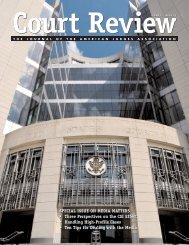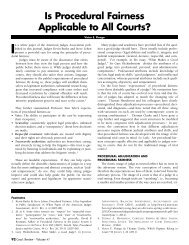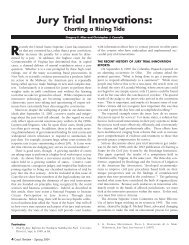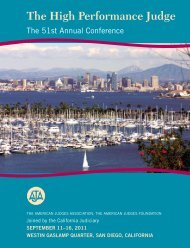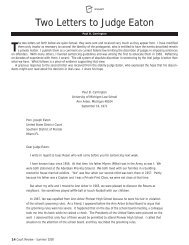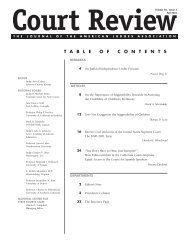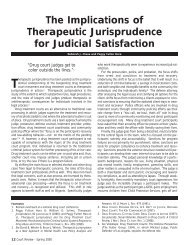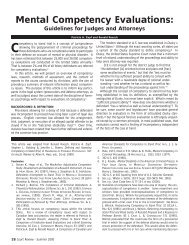Special Issue on Procedural Fairness - American Judges Association
Special Issue on Procedural Fairness - American Judges Association
Special Issue on Procedural Fairness - American Judges Association
- No tags were found...
You also want an ePaper? Increase the reach of your titles
YUMPU automatically turns print PDFs into web optimized ePapers that Google loves.
ably influenced judgments of procedural fairness am<strong>on</strong>grestaurant employees but not am<strong>on</strong>g restaurant managers, and(b) perceived procedural fairness favorably influenced proceduralapproval am<strong>on</strong>g restaurant employees, but not am<strong>on</strong>grestaurant managers. Study 4 also supported the predicti<strong>on</strong>that authorities would be more influenced than subordinatesby outcome c<strong>on</strong>cerns: (c) perceived efficacy of the procedureat reducing the Hepatitis threat had a more favorable effect <strong>on</strong>procedural fairness am<strong>on</strong>g restaurant managers than am<strong>on</strong>grestaurant employees, and (d) perceived efficacy of the procedurehad a favorable effect <strong>on</strong> procedural approval am<strong>on</strong>grestaurant managers but not am<strong>on</strong>g restaurant employees.Therefore, despite numerous differences between Study 4and the preceding studies (e.g., a shift from a legal c<strong>on</strong>text toa business c<strong>on</strong>text, a shift from a retrospective evaluati<strong>on</strong> inwhich the procedure’s outcomes were known to a prospectiveevaluati<strong>on</strong> in which the procedure’s outcomes are unknown,and a shift in the nature of the decisi<strong>on</strong> maker and decisi<strong>on</strong>recipient roles), the findings of this study are c<strong>on</strong>sistent withthose of Studies 1-3. These results supported the hypothesisthat decisi<strong>on</strong> makers’ fairness judgments and procedural evaluati<strong>on</strong>sare shaped by outcome c<strong>on</strong>cerns, in c<strong>on</strong>trast with decisi<strong>on</strong>recipients, whose fairness judgments and procedural evaluati<strong>on</strong>sare primarily influenced by treatment and relati<strong>on</strong>alc<strong>on</strong>cerns.NEW DIRECTIONS IN PROCEDURAL FAIRNESSRESEARCHIn each of the studies described above, decisi<strong>on</strong> makers anddecisi<strong>on</strong> recipients adopted different criteria when judgingprocedural fairness and procedural satisfacti<strong>on</strong>. Decisi<strong>on</strong> recipients’fairness judgments were driven primarily by c<strong>on</strong>cernsabout treatment—respectful treatment increased judgments ofprocedural fairness and satisfacti<strong>on</strong>—but decisi<strong>on</strong> makers’fairness judgments were driven primarily by c<strong>on</strong>cerns aboutoutcomes—effective threat reducti<strong>on</strong> and beneficial outcomesincreased judgments of procedural fairness and satisfacti<strong>on</strong>.While these findings point to potentially important limitati<strong>on</strong>sregarding the generalizability of some procedural fairnesseffects, they also leave a fundamental questi<strong>on</strong> unanswered:Why does this disparity between decisi<strong>on</strong> makers and decisi<strong>on</strong>recipients occur? In order to understand why decisi<strong>on</strong> makersand decisi<strong>on</strong> recipients focus <strong>on</strong> different c<strong>on</strong>cerns when judgingprocedural fairness and satisfacti<strong>on</strong>, we will c<strong>on</strong>sider themotivati<strong>on</strong>al assumpti<strong>on</strong>s of two important and influentialpsychological theories of fairness: the group value and relati<strong>on</strong>altheories. We propose that while those motivati<strong>on</strong>alassumpti<strong>on</strong>s are well suited to the situati<strong>on</strong> c<strong>on</strong>fr<strong>on</strong>ting subordinatesin their encounters with authorities, they might beless well suited to the situati<strong>on</strong> c<strong>on</strong>fr<strong>on</strong>ting authorities.PROTECTING THE GROUPVS. ASCERTAINING STATUSIN THE GROUPAccording to the groupvalue 22 and relati<strong>on</strong>al 23 theoriesof procedural fairness,respectful, trustworthy, andunbiased procedures matterbecause they communicateinformati<strong>on</strong> to people abouttheir standing in valued social[D]ecisi<strong>on</strong> makers'fairnessjudgments andproceduralevaluati<strong>on</strong>s areshaped byoutcomec<strong>on</strong>cerns....groups. These theories have been c<strong>on</strong>sistently supported instudies of decisi<strong>on</strong> recipients (who are highly motivated to beperceived as valued group members) reflecting <strong>on</strong> theirencounters with decisi<strong>on</strong> makers (who are representatives ofthe group’s values).On the other hand, decisi<strong>on</strong> makers or authorities might beless c<strong>on</strong>cerned with their group standing, since it is clearlyhigh, and instead more c<strong>on</strong>cerned with other issues. We suspectthat group authorities (including legal, as well as politicaland organizati<strong>on</strong>al authorities) are likely to see protecting theirgroup’s welfare—a motivati<strong>on</strong> that Stangor and Leary 24 claim isa primary human motivati<strong>on</strong>—as a particularly importantresp<strong>on</strong>sibility. If so, when they encounter tensi<strong>on</strong> between protectingthe group and treating group members with dignity andrespect, they might perceive a resp<strong>on</strong>sibility to attend to thepragmatic rather than the relati<strong>on</strong>al c<strong>on</strong>cerns.In <strong>on</strong>e recent study, we investigated whether authorities’ relativelygreater reliance <strong>on</strong> outcomes might be driven by theirrelatively greater c<strong>on</strong>cern with protecting their group’s welfare.In part because we think these processes are not limited tolegal settings, and because we are interested in testing theseeffects in diverse c<strong>on</strong>texts, this study, like <strong>on</strong>e of our studiesdescribed above, relied <strong>on</strong> a vignette that described a threat inan organizati<strong>on</strong>al c<strong>on</strong>text. 25Participants were instructed to imagine themselves as partof a small company as they read a letter written by the CFO tothe company employees. The letter described a financial threatto the company—the escalating cost of employee health insurance—andindicated that the CFO was c<strong>on</strong>sidering changes toemployees’ coverage in order to resp<strong>on</strong>d to this threat. In thisexperiment, as in our previous <strong>on</strong>es, we systematically variedthe perspective participants adopted as they read the letter.Participants who were randomly assigned to the decisi<strong>on</strong> makerrole imagined themselves as the CFO who wrote the letter,while participants who were randomly assigned to the decisi<strong>on</strong>recipient role imagined themselves as a company employee.The letters themselves varied <strong>on</strong> two other dimensi<strong>on</strong>s: (a)the magnitude of threat to the company posed by the escalatingcosts, and (b) whether the CFO would permit the employee to22. Tom R. Tyler, The Psychology of <strong>Procedural</strong> Justice: A Test of theGroup-Value Model, 57 J. PERSONALITY & SOC. PSYCHOL. 830 (1989).23. Tyler & Lind, supra note 5.24. Charles Stangor & Scott P. Leary, Intergroup Beliefs: Investigati<strong>on</strong>sfrom the Social Side, in 28 ADVANCES IN EXPERIMENTAL SOCIALPSYCHOLOGY 243 (Mark P. Zanna ed., 2006).25. Diane Sivasubramaniam et al., Respect and Threat: Authority-Subordinate Disparities in Resp<strong>on</strong>ses to Transgressi<strong>on</strong>, paper presentedat the annual meeting of the <strong>American</strong> Psychology-LawSociety, Jacks<strong>on</strong>ville, FL (March, 2008).Court Review - Volume 44 67



